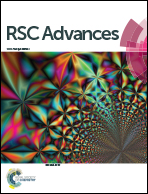Chiral conversion and periodical decay in bridged-azobenzene photoisomerization: an ab initio on-the-fly nonadiabatic dynamics simulation†
Abstract
With the implementation of global nonadiabatic switching probability algorithm based on the Zhu–Nakamura theory, we performed on-the-fly trajectory surface hopping simulations at the CASSCF level to analyze the cis ↔ trans photoisomerization mechanism of bridged-azobenzene upon S1 excitation. The cis-to-trans isomerization process was initiated by the pedal-like twist of –N![[double bond, length as m-dash]](https://www.rsc.org/images/entities/char_e001.gif) N– moiety and observed hopping to S0 mainly via the cis-form conical intersection region. While, the trans-to-cis process is induced by the nonsymmetrical torsion motion toward the central eight-membered ring and encountered surface hopping through another conical region lying in the middle of the isomerization pathway. In cis-to-trans photoisomerization, we also observed a particular chiral conversion pathway with surface hopping occurs at CI-trans conical region. The trajectories followed this pathway possess relative longer excited state lifetimes as the ∼40 fs initial stage oscillation in the cis Franck–Condon region. Moreover, the periodical population decay pattern of S1 state in trans-to-cis process was observed with an interval of ∼16 fs.
N– moiety and observed hopping to S0 mainly via the cis-form conical intersection region. While, the trans-to-cis process is induced by the nonsymmetrical torsion motion toward the central eight-membered ring and encountered surface hopping through another conical region lying in the middle of the isomerization pathway. In cis-to-trans photoisomerization, we also observed a particular chiral conversion pathway with surface hopping occurs at CI-trans conical region. The trajectories followed this pathway possess relative longer excited state lifetimes as the ∼40 fs initial stage oscillation in the cis Franck–Condon region. Moreover, the periodical population decay pattern of S1 state in trans-to-cis process was observed with an interval of ∼16 fs.


 Please wait while we load your content...
Please wait while we load your content...